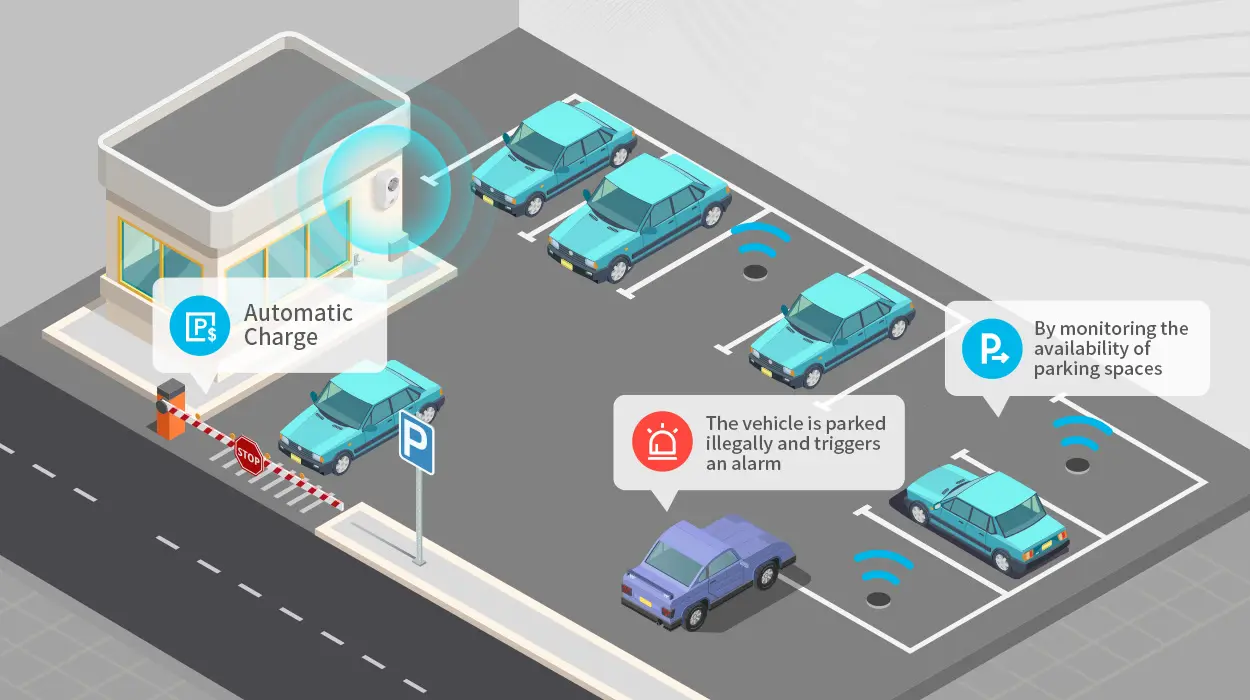The UN’s Department of Economic and Social Affairs predicted that all the world population growth will be living in the urban areas. And the growth rate is anticipated to reach 68% in 2050. Population increase is not only a pressing problem of governments, it’s also a real daily reality for most citizens. Searching for parking lot will result in the huge loss of time and money, according to the report from USA Today, there’re 35% time and 345 dollars wasted on this. Let’s dig deeper on the parking issues and the need of smart parking system using IoT.
What issues you would come into while parking vehicles?
- Parking lot is saturated– The most severe issue is the increasing number of vehicles with no increase in the parking space,hence,resulting in the jam.
- Overpay– Sometimes,drivers or customer don’t know how long they will stay at a specific place. Therefore,they overpay the parking fees somtimes.
- Environment impact– The parking lot accumulated amounts of contaminant that are unable to be absorbed,which are flushed into the water body when raining.
- On-street or Off-street parking– There’re not enough space on the parking lot of the shopping malls or reservation areas,in this case,severe traffic jam will appear.
- Improper use of existent parking lot– People are always in a hurry and get impatient to parking properly,which result in insufficient parking space for other vehicles.
Parking 4.0: The future and opportunities of smart Cities
Smart parking systems are widely used to improve People’s Daily life, so the use of smart parking systems is expected to increase constantly. The system can also add the following advanced functions, making it a multi-functional management tool.
- Parking demand management and space optimization
- Personalized parking guidance
- parking reservation system
- dynamic parking price and policy optimization
- parking area, charging, illegal parking detection
For large parking lots, augmented reality might create a mapping function on real images captured by smartphones. These AR outdoor and indoor navigation systems can guide drivers to their parked cars via virtual paths.
Another innovation is the use of visual image processing technology to catch the license plate number of a car and identify it with the help of optical character recognition technology. It then automatically opens the gate to the parking lot and the system lead the driver to a suitable parking lot space.
The future of smart parking systems seems prospective. The technologies behind this solution include the Internet of Things, artificial intelligence, machine learning and augmented reality, which are also driving the digital transformation of enterprises in industry 4.0 terms. Leveraging these innovations, Parking 4.0 will improve the efficiency of parking systems by addressing urbanization challenges.
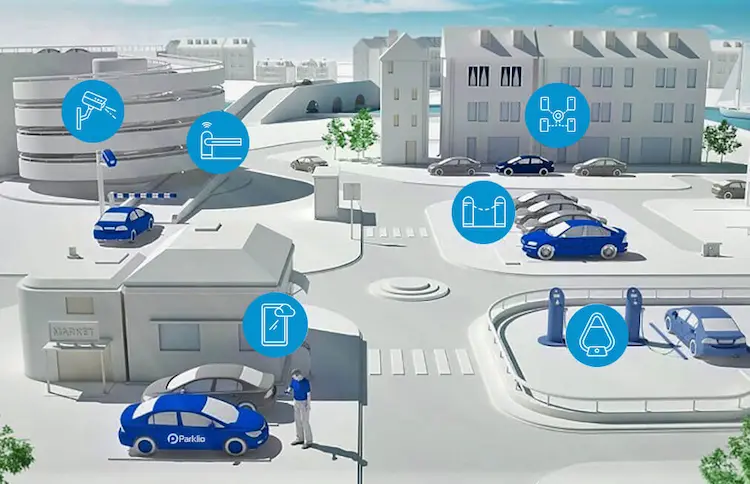
Is smart parking system the modern trend or a growing need?
The parking issue is not common,especially in the big cities. According to an IoT analysis report, the market expenditure of smart parking product and service will increase at a compound annual growth rate of 14% by 2023 and surpass 3.8 billion dollars. It’s actually a great news as it force people to find ways to solve the traffic issues rather than doing nothing. This issue is pretty obvious, but the bigger problem is that what can technology do to solve this issue and is there any ways for it?
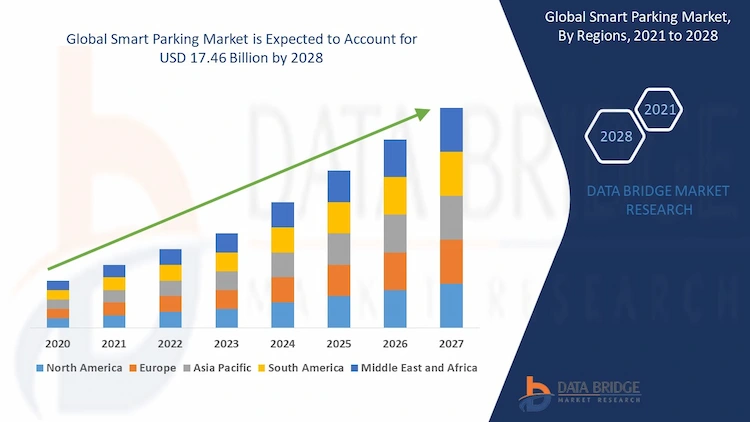
Smart parking system using IoT
Ultrasonic, electromagnetic field detection, and infrared are several types of iot smart parking sensors.
- Ultrasonic: The precision of the smart parking sensor is improved by using ultrasonic wave. The disadvantage of this type of sensor is that it can get clogged with dirt.
- Electromagnetic Field Detection: The sensor can detect small changes in the magnetic field when a metal object is near it.
- Infrared: This type of sensor measures changes in ambient temperature and detects movement.
How can you install a smart parking sensor using IoT?
Different kinds of sensors are installed in different ways. For axample,camera is tricky,so it needs to be installed in a certain distance and angle to avoid blind spot. Laser radar sensor usually be installed in a pillar with 30~80 centimeters and be located repeatedly in a certain range,but it makes sense only when conducting massive processing.
The in-ground vehicle IoT sensors are the most easiest to be installed,which usually be installed on the ground of every parking lot to detect the vehicle parked above. Such IoT sensors can be simply glued on the surface or fixed with screws. Additionally, such IoT sensors are easy to be transformed without any unique installation practice and most of them don’t need any maintainance. The smart parking system using iot can communicate with gateway through parking site and transfer the data to the internet.
Three possible detection conditions
Space ocupation: The object distance detected by the sensors is between 10~50 centimeters(about 4~20 inches)
Free space: The object distance detected is over 50 centimeters(about 20 inches)
Dirty space:The object distance detected is less than 10 centimeters(about 4 inches)
If the condition is “dirty”,then the sensors might be covered or blocked by something and need to be inspected.
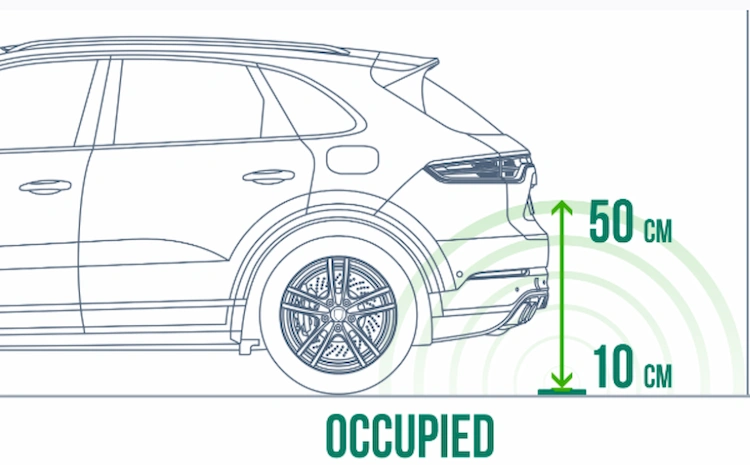
Configurate the smart parking system using IoT
The number of parking lots determines the hardware and software requirements of the iot configuration and system architecture. For large parking lot,sensors adopt the gateway and LPWAN protocol.
Adopting LoRaWAN standard is one of the tendency of IoT,also a method to increase the automatic system operating time by decreasing the power consumption. It’s under the LoRa alliance specification so as to decrease the need of replacing the battery,and battery life is expended to 5 years before getting the replacement.
What components involved in the smart parking system using IoT?
- A sensor that can detect the presence of the vehicle.
- A micro control that can help you processing the data.
- A cloud platform will restore the data.
- A mobile application enables you to control the smart parking process.
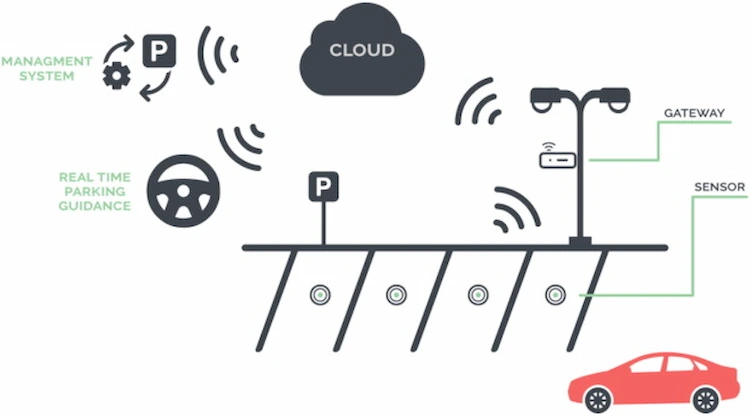
The working principle of smart parking sensors
Detect the presence of vehicle in two steps. First,the IoT solution device need to identify the presence of cars parked in the specific parking lot. Second,you need to make sure that the parking lot is detected as occupied as there’re only one car. Both of these steps can be realised through various engineering technology approaches,which allow the smart parking system using IoT to offer searching,navigation and reservation of parking lot.
Computer vision,proximity detection,distance detection,and even RF/magnetic presence can be used for building smart parking sensor. Such technologies offer advantages such as high precision parking detection,wide angle parking detection,energy saving, and monitoring multiple parking slots simultaneously. Hence,using mixed parking sensor with remote communication is the best choice. LoRa parking sensor offers the extended range required and decrease the overal cost of system due to the minimal numbers of gateway devices.
How does lora smart parking work
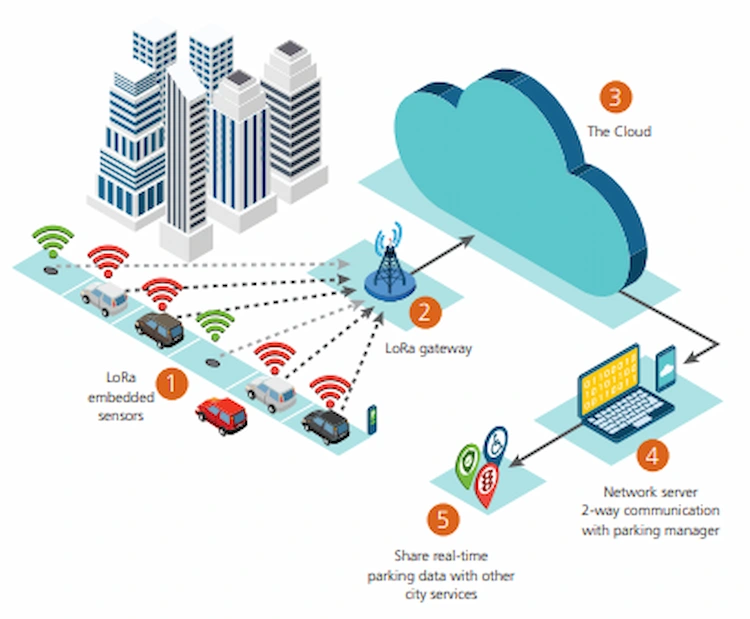
LoRa technology from MOKOSmart enables connectivity,real-time monitoring of occupancy and activity, resource optimization and integration of smart city.
1. Each parking space is equipped with a battery-powered occupancy sensor that detects the absence, arrival, presence and departure of vehicles. Due to their low-power design, these sensors can be self-configured to assign each unit a unique MAC address associated with a serial number and bar code.The unit can run up to 10 years without external wiring amounted.
2. When an occupation sensor detects vehecle activity,the embedded lora receiver will send a short message package containing the change in status to any wireless network gateway within its range.
3. Gateway can be a part of private lora network or a node of public lorawan service provider. It transmits packets to the PIN parking cloud service application, which can reside on a cloud-based server or a dedicated server. This turnkey parking management solution uses sensor information to track open and occupied Spaces. It can present the parking events in the web page and offer parking data to thrid party application that generate billing information and notify the available parking space for drivers through smart phones and other wireless devices. Moreover,it can also be customized to offer a wider specialized service.
4. The LoRaWAN protocol supports two-way communication capabilities, allowing parking lot administrators to query sensors.
5. PIN’s parking cloud service shares real-time parking data with other smart city services run by municipal and district governments. It utilize the information collected from many parts of a city’s infrastructure so as to offer unique application such as remote parking emforcement. Sensor-based parking monitors and street cameras work with other parking technologies to eliminate “camping” in short term.
How bluetooth beacon smart plarking works
The diagram below shows the architecture of our street parking management system, which has four roles: beacon emitter, beacon reader, gateway and parking server.
1. Beacon Transmitters: Drivers who are eligible to use smart Street parking must register their cars in order to obtain a registered beacon transmitter. We assume that the beacon transmitter is mounted on the vehicle’s right rearview mirror (for right-side traffic countries), which is closer to the sideway when the vehicle is parked. Beacon transmitter broadcast data package regularly,which can be detected by beacon reader. The source Bluetooth MAC address of a particular vehicle is fixed, and the beacon reader can distinguish between the owner of the received beacon packet (i.e., the vehicle).
2. Beacon reader:The beacon reader is positioned around the corner of the parking space, as shown in the picture. The reader periodically scans beacon packets with service-specific UUids from registered beacon emitters. Once the UUID matches, the reader processes the RSSI of the packet using a Kalman filter and then generates a distance estimate. Finally,readers will publish the following data to the gateway:bluetooth MAC address detected, distane estimated and time detected.
3. Gateway:The main function of the gateway is to ensure the occupancy of each parking space according to the data provided by the beacon reader. Specifically, by comparing the estimated distances measured to the same beacon transmitter at different readers, the gateway can deduce that the vehicle is parked in a particular parking space. And then the gateway will send the result to the data base of remote parking server.
4. Parking server:Parking server is responsible for resstoring the occupancy status and identity of vehecles who using the parking space. Managers can log in the system data base and check the occupancy information and parking history record. With such information,mangement system can gernerate e-parking bill for drivers,in another way,the parking server can also enable the drivers to check their own parking record.
![]()
Benefits of smart parking system using IoT
In urban areas:
Direct benefits
- Optimize parking spaces
- Special permit the loading and unloading, cabs, etc.
- Monitor parking spaces for disables
- Identify the zones for emergency vehicles
- Offer electric vehicle recharging points
Indirect benefits:
- Reduces parking violations
- Reduces pollution of noise
- Reduces emissions of gas
- Increases the parking revenues by up to 35%
- Improves reputation of being a greener city/facility
- Improves urban mobility and city planning
Private areas: malls, hotels, thematic parks…
Direct benefits
- Optimize parking spaces
- Special permits: loading and unloading, cabs, etc.
- Monitor parking spaces for people with disabilities
- Electric vehicle recharging points
- Increase revenues
Indirect benefits:
- Dynamic pricing strategies based on occupancy
- Open uses to new customers: parking spaces for car sharing vehicles.
- Improving customer experience
- Optimizing human resources to consumer habits
Smart parking system using IoT solution
Smart Parking solution can reduce
Traffic volume: -8%
Gas emissions: -40%
Km. travelled: -30%
Time spent: -43%
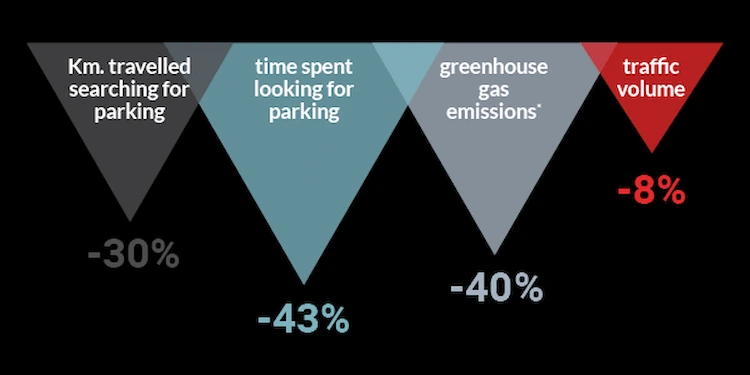
Looking for a parking spot
Taking 10 minutes searching for cars several times every day means you should spend 240 hours a year,and an average of 700 days of your whole life.
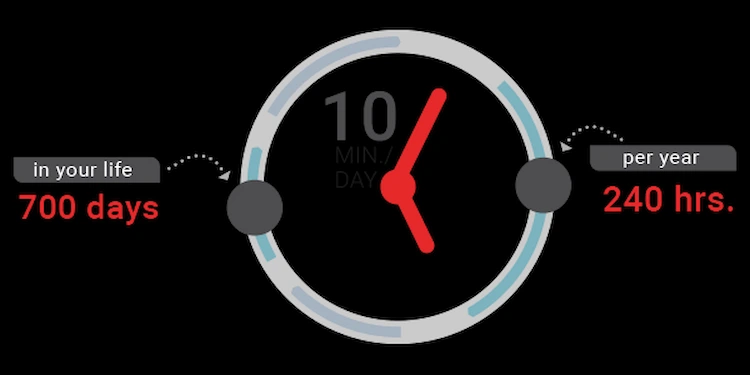
Applications of smart parking system using IoT
There are amounts of cars that need to be placed in place to avoid congestion. In this case, the parking guidance system provides the driver with direction and parking accuracy.
- Shopping malls
- Airports
- Hospitals
- Sports centers
- Universities
Innovations in smart parking solutions
As per the survey by the Smart Parking Institute, 42 percent of respondents voted in favor of the need for Parking systems. The good news is that thanks to parking lot sensor systems, connectivity platforms and other iot applications, drivers can know where the nearest parking space is if it’s occupied. Real-time parking maps will be common in the future.
As for innovations already in the field, here are the top smart parking apps that have been released or will be released soon.
1. Tracking vehecles with sensor systems
Internet of Things is the core technology of vehicle tracking platform. Tools such as GPS or OBD sensors can help collect location data from cars or fleets and monitor parking space occupancy. The information is transmitted to the CSA, processed, and then sent to the network server. This data will be shown to drivers and car company managers in an understandable and clear way.
At present, vehicle trackers based on the Internet of Things are mainly used for fleet management of large enterprise organizations. In the future, when the rollout of 5G makes the Internet of Things more accessible, parking technology will spread among car drivers and will be used to manage daily commutes and ease parking challenges.
2. Smart meter systems
The connected metering system detects when a car enters and leaves the parking lot. In this way, an iot platform will be able to provide drivers with a real-time meter of available spaces.
Facility managers can use the meter system to improve the efficiency of parking facilities, identify trends and patterns about the ridership, and be able to predict the surges of future vehicle.
3. Automatic parking systems
Automatic parking systems help reduce parking lots and maximize space efficiency. An automated system is used to move the car up and down to the upper level of the facility. Since the APS facility is fully automated and has access restrictions, it is safer to park there.
Automatic parking systems help reduce search time and engine emissions that accumulate due to increased driving time. In such a facility, the use of resources is minimized because there is little light and ventilation required to maintain the automatic parking system.
4. Control systems
The Internet of Things, as a powerful traffic law enforcer, contributes to urban security and order. Using a network of sensors and fast data-processing algorithms, the parking control system can detect, register, collect and store required evidence, issue tickets, and notify parking violations in seconds.
The role of Internet of Things in parking technology
Smart parking will have a significant impact on all stakeholders throughout the process. Drivers can book parking Spaces in advance, plan trips and commutes, and take parking lot occupancy into account. The reinforcement mechanism will be able to detect and assess the severity of illegal parking in a split second.
Parking managers will be able to optimize the use of space and resources within their parking lots, effectively formulating future developments. Community leaders will improve the comfort of city residents by applying iot parking solutions.
Here are some additional benefits that the Internet of Things offers in the parking space:
- Meter time extended
When the parking meter is about to expire, the connected platform will notify the driver. Such a tool will help extend parking time at a click once the driver pays for the extension. The automatic parking meter extension system will reduce traffic violations and increase revenue for the facility.
- Innovative parking solutions that identify the safety of parking Spaces
Red areas such as bus stops, pick-up and drop-off areas for passengers, and parking Spaces for disabled people will be identified by the platform and notified to drivers. In this way, the number of negligent parking violations will be reduced. If a driver still parks in an area where parking is prohibited, a connected platform will immediately notify the strengthening department violator, increasing the chances of a successful penalty for the violator.
- Efficient use of parking Spaces in cities
With a network of sensors, automated parking planners can collect occupancy data for all parking lots. In order to evenly distribute the number of parking Spaces in a city, municipal communities can use the data provided by the iot platform to adjust fees and allowed parking hours in the decision-making process.
IoT parking management software
A parking lot management system can be a one-stop shop, uniting parking facility managers, law enforcement agencies, drivers, and other stakeholders into a connected network. Parties affected by the transformation of parking management make contribution to the overall well-being of urban communities by connecting with each other, ask and answer questions.
To function properly, parking management systems based on the Internet of Things must make full use of the advantages of intelligent parking technology. Here are the features that an intelligent platform should take advantage of in the parking industry:
- The screen displays the available and occupied parking Spaces. Iot platforms, ideally cloud-based, should aggregate sensor data and turn it into a clear and concise view of the facility’s parking space occupancy.
- Monitor parking occupancy in real time from any PC or smartphone. Drivers should be able to see how many free parking Spaces are available near all parking facilities in real time. An interactive occupancy map is necessary for an effecient, connected parking management tool.
- API for end users and management applications. Due to the impact of a parking management tool is vital to the well-being of community members, program developers need to guarantee that the tool provides third-party integration and can be implemented into other management and parking lot monitoring tools.
- Access rights,friendly interface for different user groups. Not every driver is proficient and experienced at navigating platforms. To make searching or checking a parking lot as easy as possible, app developers should insist a minimalist interface and use guiding elements like arrows and ICONS to help users move around the app. App developers should target different user groups, such as visually impaired people, drivers over 50, etc.
